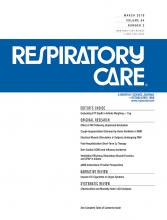March's Editor's Choice paper, by Bartle and colleagues from Duke, evaluated the proper placement of endotracheal tubes (ETTs) in infants weighing < 1 kg. In a retrospective review they compared 2 weight-based formulas for determining appropriate position of the ETT. Appropriate ETT position was defined as the tip of the ETT below the thoracic inlet and above the carina, at approximately the second or third thoracic vertebrae on chest radiograph. Both formulas had relatively low sensitivity for predicting ETT depth. The authors conclude that early chest x-ray for confirmation of ETT placement is essential. Volsko pens an accompanying editorial suggesting that potential limitations to the study, owing to the retrospective design, are many. She also argues for a reliable method for confirmation of ETT placement and a prospective trial to validate the method.
Unplanned extubation (UE) is a safety issue that can have both positive and negative outcomes. Many studies describe successful UE, suggesting perhaps, that the patient knows best. Kudela and others describe the use of noninvasive ventilation (NIV) following UE. In a group of 121 subjects experiencing 131 UEs, they found the use of NIV prolonged re-intubation as well as duration of ventilation and ICU length of stay. Rescue NIV was unsuccessful in nearly 2/3 cases. Nava and colleagues opine that this study confirms two important truths. The first is purposeful extubation at the earliest possible moment should be achieved and second, that immediate re-intubation following UE associated with overt respiratory failure should be accomplished.
Cough augmentation has been a frequent subject of research in the Journal in the past year. Del Amo Castrillo and others evaluated 2 methods of cough assist in subjects with neuro-muscular disease. Using breath stacking or a pre-programmed increase in tidal volume from a volume ventilator they found that cough peak flow was highest with the technique producing the highest inspiratory capacity. They also suggest that monitoring inspired volumes could identify the method to best increase cough peak flow. Toussaint editorializes that these methods are clever and effective. He also points out that this approach avoids the need for an ancillary device for cough assistance, reducing costs and simplifying care.
Chen et al evaluated the impact of electrical muscle stimulation on muscle function in subjects requiring prolonged mechanical ventilation. While no changes in pulmonary function were identified, they did find increases in muscle strength. Importantly, however, there were no changes in clinical outcomes.
Khor and others evaluated post-hospitalization short-term oxygen therapy in subjects who were hypoxic at hospital discharge. Using a retrospective audit over a 5-year period, they reviewed subject demographics and comorbidities, results of arterial blood gas and 6-min walk tests, along with the oxygen prescription. Half of the subjects had chronic lung disease and one quarter received oxygen for dyspnea palliation. At a 1-month follow-up, almost half of the subjects no longer met criteria for home oxygen therapy. One-year survival was only 56%.
The use of extracorporeal membrane oxygenation (ECMO) for non-cardiac indications has increased exponentially in the last 5 years. Insel and others evaluated the use of non-cardiac ECMO to determine if there was a seasonal association with influenza. They reported that non-cardiac and cardiac ECMO use in the United States were significantly associated with influenza incidence. The influenza A, H1N1 2009, subtype had the strongest association.
CPAP was introduced for neonates in the 1970s with impressive impact on outcomes. Dassios and coworkers evaluated varying levels of CPAP on muscle function in intubated infants. At 4, 6, and 8 cm H2O of CPAP there were significant differences in ventilation efficiency. In this study 6 cm H2O CPAP improved function over 4 cm H2O, but an additional step to 8 cm H2O provided no further benefit.
A number of reports demonstrate that patients fail to use pressurized metered dose inhalers (pMDIs) properly. Schmitz et al conducted a survey of pediatric primary care providers to define pMDI educational efforts. Only 10% of providers reported having patients practice inhaler technique at introduction. Time and lack of access to demo pMDIs were identified as the primary barriers to instruction. They suggest that repeated pMDI practice for motor learning could promote pMDI skill mastery.
Khor and others evaluated exertional dyspnea and the prescription for home oxygen in a group of subjects with interstitial lung disease (ILD). Their retrospective review found that exertional desaturation was common in subjects with ILD. Reduced exercise capacity and poor lung function were associated with a prescription for home oxygen therapy.
Boyer and others evaluated the use of a 10-hour E-test approach to tailoring antibiotic therapy in subjects with suspected ventilator-associated pneumonia (VAP). The goal of the bedside test is to facilitate de-escalation of antibiotic therapy to prevent resistance. They found good concordance with the 10-h E-test and traditional laboratory results. The authors speculate that rapid susceptibility testing might lead to an early adjustment of empirical antimicrobial treatment in suspected VAP.
Tuberculosis (TB) remains a common disease in certain areas. The risk of infections spreading to health care workers is a concern mitigated by universal precautions. In a 3-year study of 274 health care workers in Taiwan, Hsieh and colleagues found a very low rate of worker infection. Respiratory therapists had no higher risk for latent TB infection than other care providers in Taiwan, a country with intermediate TB incidence.
Alqahtani et al evaluated hookah smoking among college students. In a survey of over 300 students, they found that half had tried hookah smoking and that more than half believed hookah smoking was less dangerous than cigarette smoking. Importantly, knowledge of the risks and health-related attitudes towards hookah smoking were misinformed.
Eltorai et al provide a narrative review on the impact of electronic cigarettes on the lungs as well as additional organ systems. Lee and colleagues performed a systematic review on the mortality rate of mechanically ventilated subjects treated with chlorhexidine mouth care. Their results did not support the link between chlorhexidine and mortality in these subjects.
- Copyright © 2019 by Daedalus Enterprises







